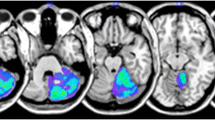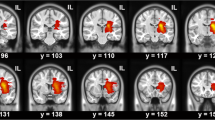Abstract
Lesions in the cerebellum produce various symptoms related to balance and motor coordination. However, the relationship between the exact topographical localization of a lesion and the resulting symptoms is not well understood in humans. In this study, we analyzed 66 consecutive patients with isolated cerebellar infarctions demonstrated on diffusion-weighted magnetic resonance imaging. We identified the involved lobules in these patients using a cross-referencing tool of the picture archiving and communication system, and we investigated the relationships between the sites of the lesions and specific symptoms using χ 2 tests and logistic regression analysis. The most common symptoms in patients with isolated cerebellar infarctions were vertigo (87%) and lateropulsion (82%). Isolated vertigo or lateropulsion without any other symptoms was present in 38% of patients. On the other hand, limb ataxia was a presenting symptom in only 40% of the patients. Lateropulsion, vertigo, and nystagmus were more common in patients with a lesion in the caudal vermis. Logistic regression analysis showed that lesions in the posterior paravermis or nodulus were independently associated with lateropulsion. Lesions in the nodulus were associated with contralateral pulsion, and involvement of the culmen was associated with ipsilateral pulsion and isolated lateropulsion without vertigo. Nystagmus was associated with lesions in the pyramis lobule, while lesions of the anterior paravermis were associated with dysarthria and limb ataxia. Our results showed that the cerebellar lobules are responsible for producing specific symptoms in cerebellar stroke patients.


Similar content being viewed by others
References
Amarenco P, Roullet E, Goujon C, Cheron F, Hauw JJ, Bousser MG. Infarction in the anterior rostral cerebellum (the territory of the lateral branch of the superior cerebellar artery). Neurology. 1991;41:253–8.
Kase CS, Norrving B, Levine SR, Babikian VL, Chodosh EH, Wolf PA, et al. Cerebellar infarction. Clinical and anatomic observations in 66 cases. Stroke. 1993;24:76–83.
Lee H. Neuro-otological aspects of cerebellar stroke syndrome. J Clin Neurol. 2009;5:65–73.
Kim HA, Lee H, Sohn SI, Yi HA, Cho YW, Lee SR, et al. Bilateral infarcts in the territory of the superior cerebellar artery: clinical presentation, presumed cause, and outcome. J Neurol Sci. 2006;246:103–9.
Exner C, Weniger G, Irle E. Cerebellar lesions in the PICA but not SCA territory impair cognition. Neurology. 2004;63:2132–5.
Lee H, Sohn SI, Cho YW, Lee SR, Ahn BH, Park BR, et al. Cerebellar infarction presenting isolated vertigo: frequency and vascular topographical patterns. Neurology. 2006;67:1178–83.
Lee H, Yi HA, Cho YW, Sohn CH, Whitman GT, Ying S, et al. Nodulus infarction mimicking acute peripheral vestibulopathy. Neurology. 2003;60:1700–2.
Lee BI, Nam HS, Heo JH, Kim DI. Yonsie stroke registry. Analysis of 1,000 patients with acute cerebral infarctions. Cerebrovasc Dis. 2001;12:145–51.
Tatu L, Moulin T, Bogousslavsky J, Duvernoy H. Arterial territories of human brain: brainstem and cerebellum. Neurology. 1996;47:1125–35.
Courchesne E, Press GA, Murakami J, Berthoty D, Grafe M, Wiley CA, et al. The cerebellum in sagittal plane–anatomic-MR correlation: 1. The vermis. AJR Am J Roentgenol. 1989;153:829–35.
Schmahmann JD, Doyon J, McDonald D, Holmes C, Lavoie K, Hurwitz AS, et al. Three-dimensional MRI atlas of the human cerebellum in proportional stereotaxic space. Neuroimage. 1999;10:233–60.
Adams Jr HP, Bendixen BH, Kappelle LJ, Biller J, Love BB, Gordon DL, et al. Classification of subtype of acute ischemic stroke. Definitions for use in a multicenter clinical trial. TOAST. Trial of Org 10172 in acute stroke treatment. Stroke. 1993;24:35–41.
Bertholon P, Michel D, Convers P, Antoine JC, Barral FG. Isolated body lateropulsion caused by a lesion of the cerebellar peduncles. J Neurol Neurosurg Psychiatry. 1996;60:356–7.
Allum JH, Adkin AL. Improvements in trunk sway observed for stance and gait tasks during recovery from an acute unilateral peripheral vestibular deficit. Audiol Neurootol. 2003;8:286–302.
Hotson JR, Baloh RW. Acute vestibular syndrome. N Engl J Med. 1998;339:680–5.
Kim SH, Cho J, Cho JH, Han SW, Kim SM, Park SC, et al. Isolated lateropulsion by a lesion of the dorsal spinocerebellar tract. Cerebrovasc Dis. 2004;18:344–5.
Thomke F, Marx JJ, Iannetti GD, Cruccu G, Fitzek S, Urban PP, et al. A topodiagnostic investigation on body lateropulsion in medullary infarcts. Neurology. 2005;64:716–8.
Bassetti C, Bogousslavsky J, Mattle H, Bernasconi A. Medial medullary stroke: report of seven patients and review of the literature. Neurology. 1997;48:882–90.
Cho HJ, Choi HY, Kim YD, Seo SW, Heo JH. The clinical syndrome and etiological mechanism of infarction involving the nucleus prepositus hypoglossi. Cerebrovasc Dis. 2008;26:178–83.
Seo SW, Shin HY, Kim SH, Han SW, Lee KY, Kim SM, et al. Vestibular imbalance associated with a lesion in the nucleus prepositus hypoglossi area. Arch Neurol. 2004;61:1440–3.
Yi HA, Kim HA, Lee H, Baloh RW. Body lateropulsion as an isolated or predominant symptom of a pontine infarction. J Neurol Neurosurg Psychiatry. 2007;78:372–4.
Moon IS, Kim JS, Choi KD, Kim MJ, Oh SY, Lee H, et al. Isolated nodular infarction. Stroke. 2009;40:487–91.
Lee H. Isolated body lateropulsion caused by a lesion of the rostral vermis. J Neurol Sci. 2006;249:172–4.
Dietrichs E. Clinical manifestation of focal cerebellar disease as related to the organization of neural pathways. Acta Neurol Scand Suppl. 2008;188:6–11.
Matsushita M, Tanami T, Yaginuma H. Differential distribution of spinocerebellar fiber terminals within the lobules of the cerebellar anterior lobe in the cat: an anterograde WGA-HRP study. Brain Res. 1984;305:157–61.
Ruggiero D, Batton 3rd RR, Jayaraman A, Carpenter MB. Brain stem afferents to the fastigial nucleus in the cat demonstrated by transport of horseradish peroxidase. J Comp Neurol. 1977;172:189–209.
Eager RP. Patterns and mode of termination of cerebellar cortico-nuclear pathways in the monkey (Macaca mulatta). J Comp Neurol. 1966;126:551–66.
Walberg F, Pompeiano O, Brodal A, Jansen J. The fastigiovestibular projection in the cat. An experimental study with silver impregnation methods. J Comp Neurol. 1962;118:49–75.
Igarashi M, Levy JK, Reschke MF, Kubo T, Watson T. Locomotor dysfunction after surgical lesions in the unilateral vestibular nuclei region in squirrel monkeys. Arch Otorhinolaryngol. 1978;221:89–95.
Klinkhachorn PS, Haines DE. Cerebellar cortical efferent fibers in the North American opossum, Didelphis virginiana. II. The posterior vermis. J Comp Neurol. 1984;227:439–51.
Angaut P, Brodal A. The projection of the “vestibulocerebellum” onto the vestibular nuclei in the cat. Arch Ital Biol. 1967;105:441–79.
Precht W, Volkind R, Maeda M, Giretti ML. The effects of stimulating the cerebellar nodulus in the cat on the responses of vestibular neurons. Neuroscience. 1976;1:301–12.
Baier B, Stoeter P, Dieterich M. Anatomical correlates of ocular motor deficits in cerebellar lesions. Brain. 2009;132:2114–24.
Nyberg-Hansen R, Horn J. Functional aspects of cerebellar signs in clinical neurology. Acta Neurol Scand Suppl. 1972;51:219–45.
Urban PP, Marx J, Hunsche S, Gawehn J, Vucurevic G, Wicht S, et al. Cerebellar speech representation: lesion topography in dysarthria as derived from cerebellar ischemia and functional magnetic resonance imaging. Arch Neurol. 2003;60:965–72.
Kumral E, Celebisoy M, Celebisoy N, Canbaz DH, Calli C. Dysarthria due to supratentorial and infratentorial ischemic stroke: a diffusion-weighted imaging study. Cerebrovasc Dis. 2007;23:331–8.
Grodd W, Hulsmann E, Lotze M, Wildgruber D, Erb M. Sensorimotor mapping of the human cerebellum: fMRI evidence of somatotopic organization. Hum Brain Mapp. 2001;13:55–73.
Colebatch JG, Deiber MP, Passingham RE, Friston KJ, Frackowiak RS. Regional cerebral blood flow during voluntary arm and hand movements in human subjects. J Neurophysiol. 1991;65:1392–401.
Komaba Y, Mishina M, Utsumi K, Katayama Y, Kobayashi S, Mori O. Crossed cerebellar diaschisis in patients with cortical infarction: logistic regression analysis to control for confounding effects. Stroke. 2004;35:472–6.
Acknowledgment
This work was supported by a grant from the Korea Healthcare Technology Research and Development Project, Ministry for Health, Welfare and Family Affairs, Republic of Korea (A085136).
Disclosures
The authors report no conflicts of interests.
Author information
Authors and Affiliations
Corresponding author
Rights and permissions
About this article
Cite this article
Ye, B.S., Kim, Y.D., Nam, H.S. et al. Clinical Manifestations of Cerebellar Infarction According to Specific Lobular Involvement. Cerebellum 9, 571–579 (2010). https://doi.org/10.1007/s12311-010-0200-y
Published:
Issue Date:
DOI: https://doi.org/10.1007/s12311-010-0200-y




